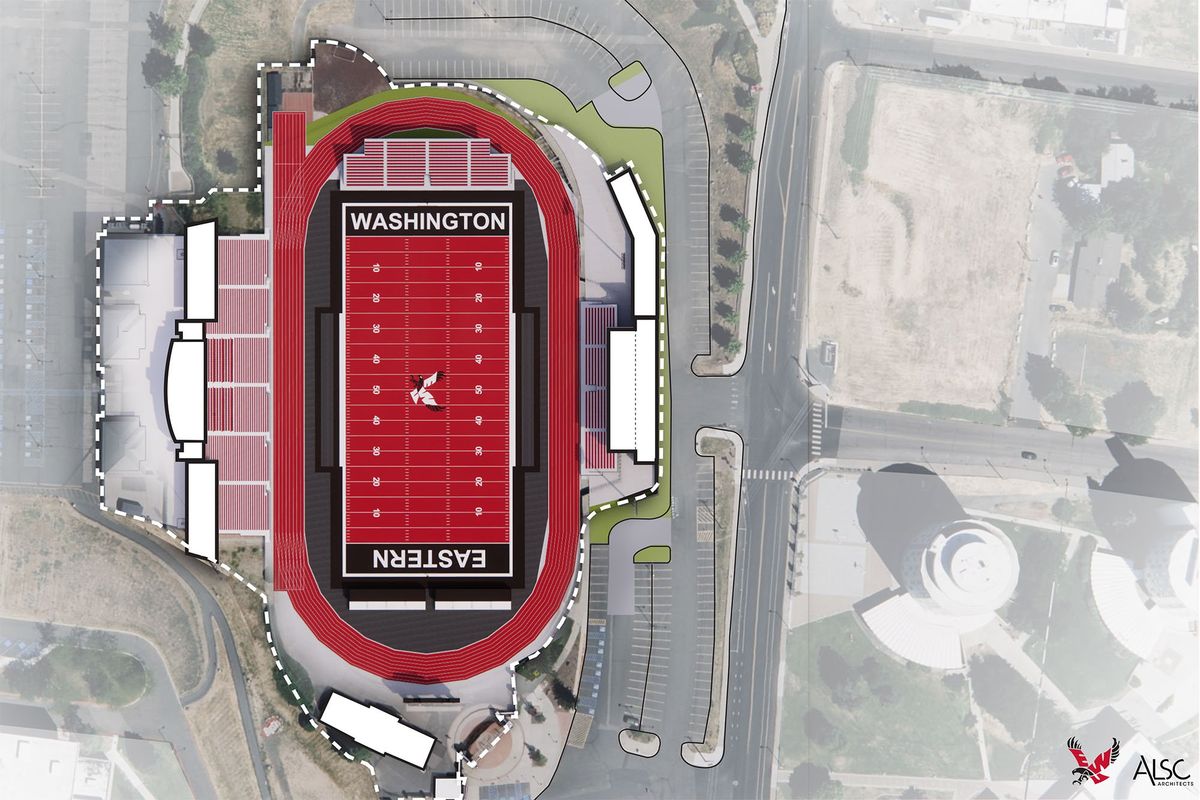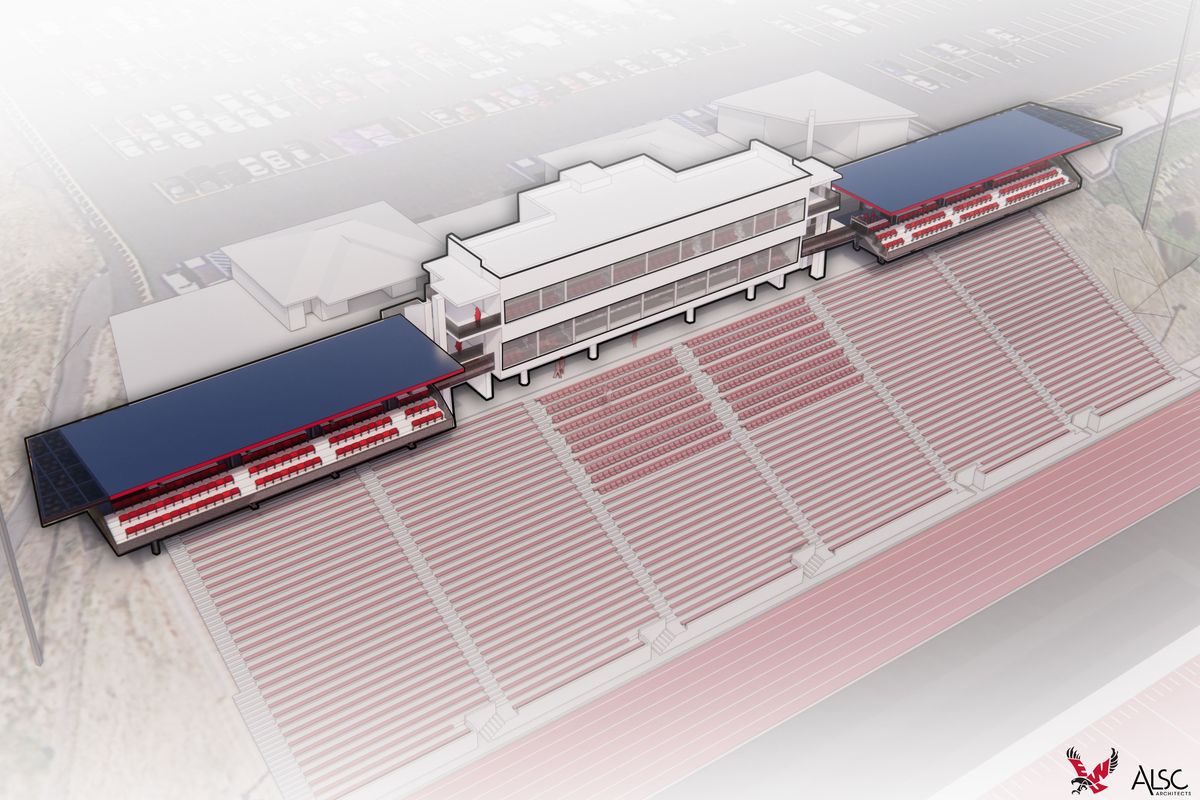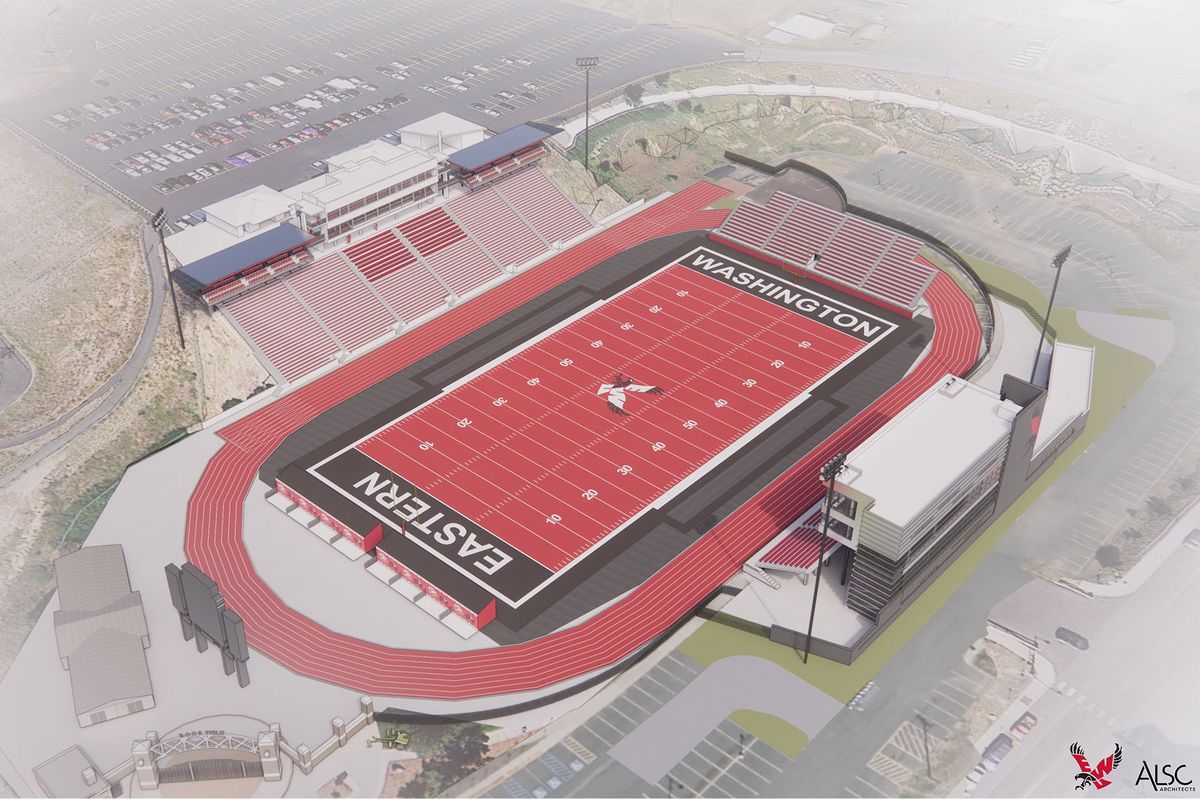With $6 million in pledged support, EWU shifts focus back to Roos Field upgrades
Proposed changes at Roos Field at Eastern Washington University would include a new press box on the visitors’ side and additional seating above the main grandstand. (Courtesy of ALSC architects)
As Division I football programs around the West are figuring out which conference will be their home, Eastern Washington University is prepared to make a renewed investment and commitment to its own football program.
Picking up on a project it most recently proposed five years ago, this week Eastern Washington announced plans – including a financial commitment from the university’s president and board of trustees – to renovate Roos Field, contingent on raising $13 million in pledged donations.
“Our university leadership and our board of trustees are committed to being a vibrant and thriving member of the Big Sky Conference,” EWU Athletics Director Tim Collins said Wednesday, “and I think you can see how that falls in line with our university’s aspirations as a whole, where we’re being positioned as a university and how we serve Spokane County.”
The price tag for the renovations is $25 million, approximately the same figure that the university had on a similar project that it announced in 2019. With the exception of replacing the red turf in 2020, that project never got off the ground.
The department has raised $6 million in pledges for the stadium renovation, which would be entirely funded by donations and future revenues raised from within the athletic department.
“The Board of Trustees is proud to support the revitalization of our athletics program and campus infrastructure,” EWU Board Chair Uriel Iniguez said in a statement to The Spokesman-Review. “This stadium expansion aligns with our on-going commitment to strengthen the university’s visibility in the region and invest in Eastern Washington University’s future.”
In December, the University Services Task Force submitted a report with its assessment of all of EWU’s programs, including football. This was part of the university’s strategic resource allocation process, which began in December 2022 and examined the ways resources are invested at EWU.
The USTF’s recommendation nine months ago was that “football needs to be transformed in order to bring it in line with EWU’s budget challenges and other regional universities in our area” and that “EWU’s leadership needs to consider all options to decrease football’s unstainable deficit spending, including moving football to a lower division.”
On Thursday, as part of the SRA process, EWU released its action plan in response to the USTF’s recommendations. The report categorizes all of the university’s programs into five quintiles: invest, maintain, streamline, transform and disinvest. In line with the USTF recommendations, football landed in the “transform” quintile.
The action plan’s response to the USTF’s recommendation for football says: “As a regional comprehensive university, EWU benefits significantly from the 30,000+ visitors that EWU Football draws to campus annually, along with substantial engagement across our social media platforms. These efforts not only enhance the university’s visibility but also create opportunities for broader campus engagement.”
The response goes on to affirm EWU’s desire to renovate Roos Field.
If the program secures $7 million more in pledged support, Collins said, the university is comfortable financing the $25 million renovation, which he said would be paid for by future pledges and revenues out of the athletic department budget.
Collins estimated that the improvements to the stadium would help the program generate another $1 million annually in revenues. Those could come from various sources beyond concessions – “that’s a lot of hot dogs,” Collins said – such as event tickets and renting out the space. He also noted the department’s EWU Night of Champions, an event first hosted last summer and something Collins said will be an annual event, as another new stream of revenue.
According to sports data annually collected by USA Today, EWU’s athletic revenues last year were $12.9 million, second fewest among the Big Sky’s 10 full-time members.
Collins described Eastern’s athletics budget as “stable” and said that they have established a baseline expectation about what the department’s needs are.
In a statement, EWU President Shari McMahan expressed her support for the project.
“We are so excited to announce the redesign of our football stadium: a long-awaited project that will not only enhance EWU football but also serve as a gathering place for our community,” McMahan said in the statement provided to The Spokesman-Review. “This investment and transformation align with our commitment to providing our student-athletes a top-tier experience, while also reinforcing the vital role that athletics plays in fostering school spirit and regional pride. I’m proud of the collaborative efforts that have brought us to this point and look forward to seeing the positive impact it will have for our fans and the entire Eastern community.”
The SRA report was released two days before Eastern Washington’s football team is set to host Montana, whose most recent annual athletics revenues were $28.9 million. Idaho, another Big Sky school, had revenues of $23 million last year.
The proposed renovation at Roos Field includes a number of upgrades, including the addition of new club seats at the top of the bleachers on the west side of the field. The current structure that includes the press box would be redesigned to include more suites and club seating.
A new press box would be built on the opposite side of the field in a space that would also include new concessions. New restrooms on that side of the field would also be built.
One aspect of the renderings that has been added is the suites behind the south end zone. They debuted this season and have generated more than the goal of $100,000 in revenue, Collins said.
All of the suites have been purchased for Saturday’s game against Montana.
A primary goal of the upgrades is to offer more ways to get people into the stadium, Collins said, and the end-zone suites are one such example of that.
“One of the things we had to do was diversify our product offerings in the stadium,” Collins said.
“Last year, all we had was the outdoor bleacher seat and the suite. We have to be able to engage different people in our community to encourage more people to come down from Spokane.
“If we’re going to expect people to come to our games and celebrate our university, we have to provide them with the amenities they’ve become accustomed to at other venues.”
The most recent update to Roos Field, prior to the end-zone suites, was a newly installed red turf in 2020 that replaced the first red turf field that debuted in 2010.
The turf replacement was part of the 2019 renovation plan, and the turf’s cost of approximately $1 million was funded as a portion of a $5 million donation to the EWU stadium fund by Spokane business owner and Cheney resident Jack Gillingham.


